Related Research Articles
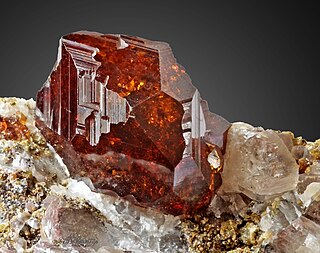
Garnets are a group of silicate minerals that have been used since the Bronze Age as gemstones and abrasives.

Kimberlite is an igneous rock and a rare variant of peridotite. It is most commonly known to be the main host matrix for diamonds. It is named after the town of Kimberley in South Africa, where the discovery of an 83.5-carat (16.70 g) diamond called the Star of South Africa in 1869 spawned a diamond rush and the digging of the open-pit mine called the Big Hole. Previously, the term kimberlite has been applied to olivine lamproites as Kimberlite II, however this has been in error.

Uvarovite is a chromium-bearing garnet group species with the formula: Ca3Cr2(SiO4)3. It was discovered in 1832 by Germain Henri Hess who named it after Count Sergei Semenovitch Uvarov (1765–1855), a Russian statesman and amateur mineral collector. It is classified in the ugrandite group alongside the other calcium-bearing garnets andradite and grossular.

Diopside is a monoclinic pyroxene mineral with composition MgCaSi
2O
6. It forms complete solid solution series with hedenbergite and augite, and partial solid solutions with orthopyroxene and pigeonite. It forms variably colored, but typically dull green crystals in the monoclinic prismatic class. It has two distinct prismatic cleavages at 87 and 93° typical of the pyroxene series. It has a Mohs hardness of six, a Vickers hardness of 7.7 GPa at a load of 0.98 N, and a specific gravity of 3.25 to 3.55. It is transparent to translucent with indices of refraction of nα=1.663–1.699, nβ=1.671–1.705, and nγ=1.693–1.728. The optic angle is 58° to 63°.

Eclogite is a metamorphic rock containing garnet (almandine-pyrope) hosted in a matrix of sodium-rich pyroxene (omphacite). Accessory minerals include kyanite, rutile, quartz, lawsonite, coesite, amphibole, phengite, paragonite, zoisite, dolomite, corundum and, rarely, diamond. The chemistry of primary and accessory minerals is used to classify three types of eclogite. The broad range of eclogitic compositions has led a longstanding debate on the origin of eclogite xenoliths as subducted, altered oceanic crust.

Almandine, also known as almandite, is a species of mineral belonging to the garnet group. The name is a corruption of alabandicus, which is the name applied by Pliny the Elder to a stone found or worked at Alabanda, a town in Caria in Asia Minor. Almandine is an iron alumina garnet, of deep red color, inclining to purple. It is frequently cut with a convex face, or en cabochon, and is then known as carbuncle. Viewed through the spectroscope in a strong light, it generally shows three characteristic absorption bands.

Enstatite is a mineral; the magnesium endmember of the pyroxene silicate mineral series enstatite (MgSiO3) – ferrosilite (FeSiO3). The magnesium rich members of the solid solution series are common rock-forming minerals found in igneous and metamorphic rocks. The intermediate composition, (Mg,Fe)SiO
3, has historically been known as hypersthene, although this name has been formally abandoned and replaced by orthopyroxene. When determined petrographically or chemically the composition is given as relative proportions of enstatite (En) and ferrosilite (Fs) (e.g., En80Fs20).
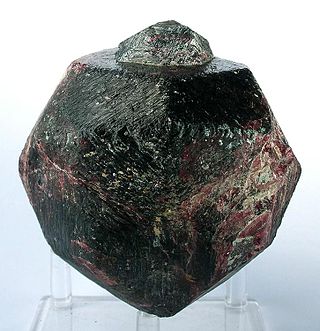
The mineral pyrope is a member of the garnet group. Pyrope is the only member of the garnet family to always display red colouration in natural samples, and it is from this characteristic that it gets its name: from the Greek words for fire and eye. Despite being less common than most garnets, it is a widely used gemstone with numerous alternative names, some of which are misnomers. Chrome pyrope, and Bohemian garnet are two alternative names, the usage of the latter being discouraged by the Gemological Institute of America. Misnomers include Colorado ruby, Arizona ruby, California ruby, Rocky Mountain ruby, Elie Ruby, Bohemian carbuncle, and Cape ruby.

Lamproite is an ultrapotassic mantle-derived volcanic or subvolcanic rock. It has low CaO, Al2O3, Na2O, high K2O/Al2O3, a relatively high MgO content and extreme enrichment in incompatible elements.

Spessartine is a nesosilicate, manganese aluminium garnet species, Mn2+3Al2(SiO4)3. This mineral is sometimes mistakenly referred to as spessartite.
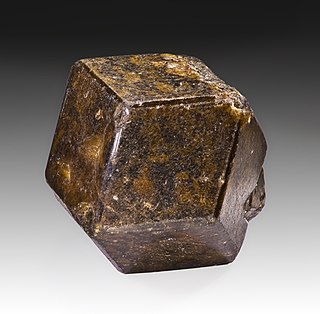
Andradite is a mineral species of the garnet group. It is a nesosilicate, with formula Ca3Fe2Si3O12.
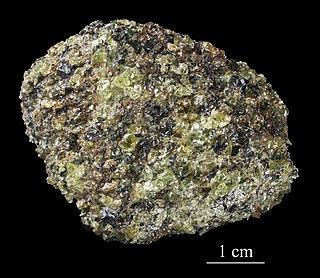
Lherzolite is a type of ultramafic igneous rock. It is a coarse-grained rock consisting of 40 to 90% olivine along with significant orthopyroxene and lesser amounts of calcic chromium-rich clinopyroxene. Minor minerals include chromium and aluminium spinels and garnets. Plagioclase can occur in lherzolites and other peridotites that crystallize at relatively shallow depths. At greater depth plagioclase is unstable and is replaced by spinel. At approximately 90 km depth, pyrope garnet becomes the stable aluminous phase. Garnet lherzolite is a major constituent of the Earth's upper mantle. Lherzolite is known from the lower ultramafic part of ophiolite complexes, from alpine-type peridotite massifs, from fracture zones adjacent to mid-oceanic ridges, and as xenoliths in kimberlite pipes and alkali basalts. Partial melting of spinel lherzolite is one of the primary sources of basaltic magma.

Rhodolite is a varietal name for rose-pink to red mineral pyrope, a species in the garnet group. It was first described from Cowee Valley, Macon County, North Carolina. The name is derived from the Greek "rhodon" for "rose-like", in common with other pink mineral types. This coloration, and the commonly inclusion-free nature of garnet from this locality, has led to rhodolite being used as a gemstone. Rhodolite like other varietal names is not officially recognized as a mineralogical term, but rather used as an accepted trade name.

Clinopyroxene thermobarometry is a scientific method that uses the mineral clinopyroxene to determine the temperature and pressure of the magma when the mineral crystalized. Clinopyroxene is found in many igneous rocks, so the method can be used to determine information about the entire rock. Many different minerals can be used for geothermobarometry, but clinopyroxene is especially useful because it's a common phenocryst in igneous rocks and easy to identify, and the crystallization of jadeite, a type of clinopyroxene, implies a growth in molar volume, making it a good indicator of pressure.

Hugo T. Dummett (1940–2002) was a South African mineral-exploration geologist who is best known for his role in the discovery of the Ekati Diamond Mine in the Barren Lands of Canada's Northwest Territories. Dummett has been described as "the brains, the ideas and the energy" behind the discovery of Ekati, which led to the creation of a new Canadian diamond-mining industry.

The Elliott County Kimberlite was discovered in Elliott County, Kentucky, by Albert R. Crandall in 1884 over two years before Carvill Lewis named a similar porphyritic peridotite occurring near Kimberley, South Africa, a kimberlite. It occurs as three separate elongate intrusive bodies 1/4 to 1/2 mi in length and a few hundred feet in width, within an area of about a square mile. The rock is a dark-green peridotite (kimberlite) composed of serpentinized olivine and a number of accessory minerals, including phlogopite, pyrope, calcite, enstatite, magnesian ilmenite, and others. Xenoliths, mainly of shale, and igneous rock inclusions are abundant in the three intrusive bodies as described by William Brown in 1977. Detailed petrographic descriptions of the peridotite are presented by Diller in 1887 and Bolivar in 1982. The peridotite has been dated to Early Permian time by K-Ar and Rb-Sr dating of xenocrystic biotite from one of the intrusive masses, however more recent evidence points to a Cretaceous emplacement. The rock is relatively nonresistant, is commonly disintegrated to as much as 50 feet, and usually asserts no topographical expression. Unweathered rock is hard, dark greenish black and weathers to grayish olive. The saprolite is yellowish to reddish brown and strewn with garnet and ilmenite fragments and xenoliths. Several attempts have been made to find diamonds in the kimberlite with no success.
The mining industry of Lesotho is mostly concentrated on diamond mining and as such the mining sector in the country has not played any significant role in furthering its economy. Apart from diamonds, the country's main mineral resources have been identified as base metals, clays, dimension stone, sand, gravel and uranium. The lack of initiative to extract other minerals commercially is mainly attributed to the inadequacy of infrastructure and finances. Between 2000 and 2011, the percentage of GDP contributed by diamond mining to Lesotho's economy rose from "virtually zero" to about 4%.
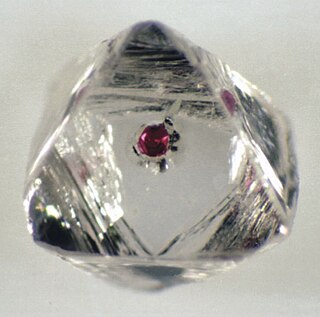
Diamond inclusions are the non-diamond materials that get encapsulated inside diamond during its formation process in the mantle. The trapped materials can be other minerals or fluids like water. Since diamonds have high strength and low reactivity with either the inclusion or the volcanic host rocks which carry the diamond to the Earth's surface, the diamond serves as a container that preserves the included material intact under the changing conditions from the mantle to the surface. Although diamonds can only place a lower bound on the pressure of their formation, many inclusions provide additional constraints on the pressure, temperature and even age of formation.
References
- ↑ Warr, L.N. (2021). "IMA–CNMNC approved mineral symbols". Mineralogical Magazine. 85 (3): 291–320. Bibcode:2021MinM...85..291W. doi: 10.1180/mgm.2021.43 . S2CID 235729616.
- 1 2 Mindat.org
- 1 2 3 4 Handbook of Mineralogy
- ↑ Webmineral description
- ↑ Nixon, P.H. and G. Hornung (1968) A new chromium garnet end member, knorringite, from kimberlite, Amer. Mineral., 53, 1833 - 1840